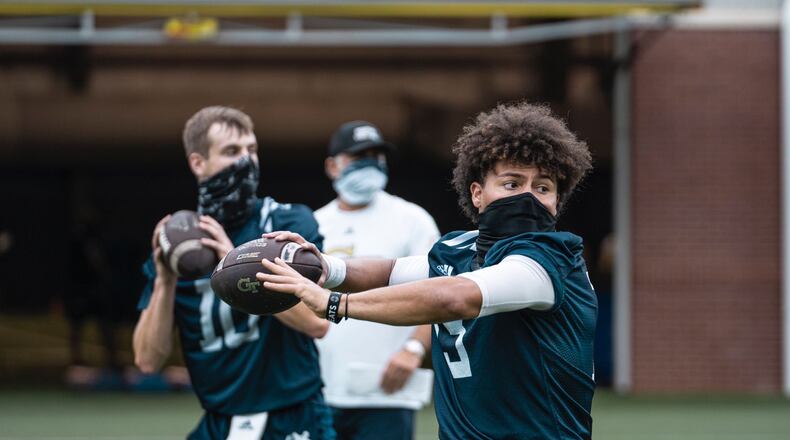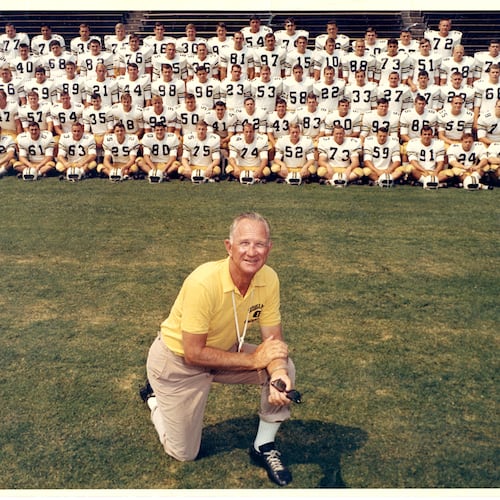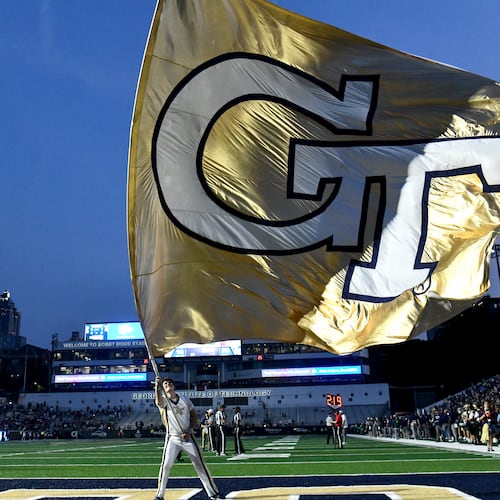After six practices in the spring, a summer of videoconference tutorials and several walk-throughs, Georgia Tech’s quarterback derby has commenced in earnest.
With a four-man race between returning starter James Graham, backup Jordan Yates and incoming freshmen Tucker Gleason and Jeff Sims, the identity of the Yellow Jackets’ starting quarterback for the season opener – and possibly well into the future – is being determined under the eye of offensive coordinator Dave Patenaude in Tech’s preseason.
“The plan is not to have to play two, three or four guys,” Patenaude said Friday via videoconference following the team’s third preseason practice. “We’d love to be able to settle on one guy and have him have a tremendous year, but we’re going to give all those guys equal opportunity to figure it out.”
Patenaude knows of what he speaks. He played three quarterbacks in Tech’s first two games last season before Graham claimed the job in the fourth game of the season.
With Graham the relative veteran as a sophomore – Yates is a redshirt freshman – Tech may have the youngest group of scholarship quarterbacks in FBS. Tobias Oliver, who started the first and fourth games of last season, is now at cornerback. Lucas Johnson, who started the second and third games, left as a grad transfer for San Diego State in his hometown.
Graham started the final eight games, at times showing stunning playmaking ability on deep balls and run plays and his inexperience at others. While taking on the challenge of leading an offense that was playing a new scheme that was markedly different than the previous style, Graham was at his best in leading the Jackets to a 28-26 home win over N.C. State with three touchdown passes and 112 rushing yards.
“The cool thing for him is that he was able to (play consistently), so he’s got game reps under his belt,” Patenaude said. “He’s extremely athletic, he’s got a live arm and he has a better understanding of what he’s doing with the ball, which is critical for him. The biggest thing that he has to be able to do is throw the ball consistently in the intermediate pass game.”
Graham saw his footwork, his timing in the passing game and his ability to read defenses as his areas needing improvement.
“It’s just developing, trying to learn from my mistakes,” Graham said. “I believe that my biggest downfall is my footwork, and I’ve been working on that all summer, and you guys will see.”
Yates impressed Patenaude in practice last fall, leading him to try to carve out playing time for him at the end of the season. Patenaude pointed out his intelligence and his knowledge of the offense. He is the shortest of the four – he’s listed at 6-foot-0, but Patenaude said he was 5-10 – which limits his vision in the pocket.
“But he’s able to kind of frame throws and throw around people and move his feet and scramble and find throwing lanes and, you know, throw it behind his back, throw it over his head,” Patenaude said. “He had a jump pass (Thursday), an old-school jump pass. So he’s good at improvising, and he’s very, very smart.”
After a summer of uncertainty, Yates said that it has felt good to be back at practice.
“We all push each other in every drill, and we just have fun and compete,” Yates said.
Gleason, an early enrollee like Sims, has good size – 6-3 and 225 pounds – and came from a powerhouse at Tampa (Fla.) Plant High, which produced former Georgia star Aaron Murray, among a number of other FBS quarterbacks. Patenaude said he has a good feel for the game and is athletic for his size.
“He understands concepts,” Patenaude said. “He’s very smart with where to go with the ball. We’re tinkering with a few things with his delivery right now to kind of drive the ball a little bit more instead of opening his hips up a little bit, but he’s handled things very, very well.”
Sims was a four-star prospect from Sandalwood High in Jacksonville, Fla. He was a late commit to Tech after previously committing to Florida State. Patenaude said that Sims is more athletic than he thought when Tech recruited him.
“He’s a worker,” Patenaude said. “He’s very smart. He understands football. For a kid that’s that big, he can really spin the ball really well. We’re working on a couple things technically with him, too.”
Patenaude will go with the quarterback who can lead the offense most effectively, making the right decisions before the snap and executing the passing game after it. He is rotating the four with different groups in practice.
“Sometimes the older guys are together, sometimes the younger guys are together,” Patenaude said. “Sometimes we split it up, trying to get all of those guys equal looks, give them all an opportunity to work with some of the older guys and some of the younger guys.”
Patenaude used the quarantine period to teach the offense to the quarterbacks via videoconference, which he said was beneficial.
“Because you can see right now, all of the guys are going to the right spots, which was not the case last year,” he said. “And their understanding of what they’re doing is so much better.”
While starting roles are obviously subject to change, whoever earns the nod gets a leg up to build up experience and develop proficiency. Given that it’s a group of three freshmen and a sophomore, it’s an opportunity to hold the job for a long time.
About the Author
Keep Reading
The Latest
Featured




